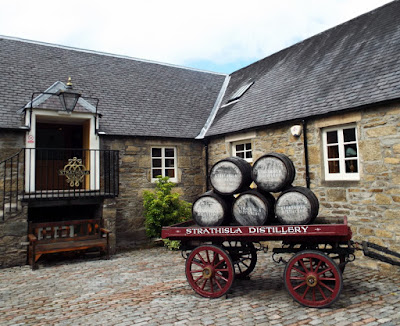First, a weather report. It has been great! Looking at the weather online before we left home, rain was predicted every day. The good news is that it has sprinkled or briefly rained every afternoon but mostly sunny otherwise.......So far. The bad news is, we are told over and over that this type of weather is very unusual, it is normally very rainy all the time. So we'll see.
Our first stop today was the RRS Discovery. It was the last traditional wooden three-masted ship to be built in Britain. And, designed soled for Antarctic research. It was launched as a Royal Research Ship (RRS) in 1901. Its first mission was the British National Antarctic Expedition, carrying Robert Falcon Scott and Ernest Shackleton on their first, successful journey to the Antarctic. It is now the centerpiece of a visitor attraction in Dundee.
Although not as meticulously maintained and curated as the Britannia that we boarded yesterday; it was a working ship that, for its time in history, would be similar to the Apollo program in a modern age. They did hard research for three years in the Antarctic, with many dangers, perils, victories and discoveries.
Part of the lab on board. Geology, meteorology, botany, zoology. They even
put up a hot air balloon to do some aerial research
This was the galley. Note the cat in the far corner, she made it all the
way to the South Pole. (Their mascot dog, was dropped off at
Cape Town, South Africa)
This was where the illustrator did his plant and animal drawings. They had
still and moving pictures, but this was the only way they could capture colors.
Our next stop was the Glamis Castle, (pronounced Glamz). A "starter castle' was built in 1376, and as they say, the rest is history. Currently the Earl and Countess of Strathmore live there, but it's claim to fame is it was the favorite castle for the Queen Mum, (Queen Elizabeth 1900-2002). She was actually born here, grew up here, and spent much of her later years here.
Unfortunately, no photos inside, but we were led by a docent through probably 1% of the castle. There was so much history to hear and see, we didn't need to check out the rest of the castle. A bit of trivia; old and new. Next to the billiard room was a small room, small door, small chair. We were told this is where the men went after dinner and before billiards to have their make up reapplied and their powered wigs shaken to dislodge as many bugs as possible.
The modern bit of trivia, in the family chapel the docent showed us a small framed silver/chrome cross. This was created and given to the castle by a former International Space Station astronaut who, while visiting the Glamis Castle, fell in love with another tourist and got married in the chapel. He "took part of the space station" to fashion this cross to donate to the castle. Our guide attended the wedding and stated "there were lots of astronauts here"!
Great gardens surrounded the castle














































